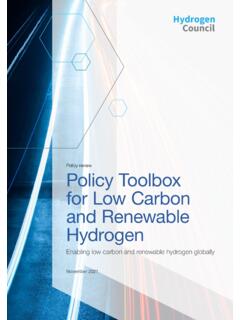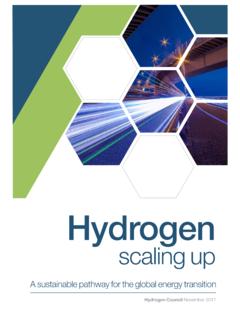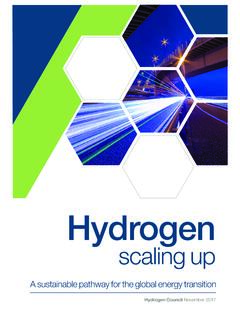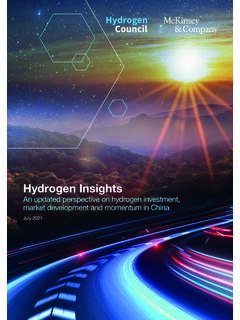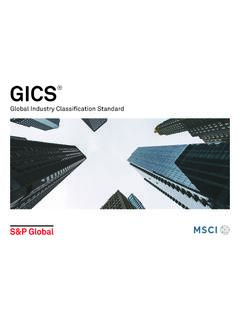Transcription of Hydrogen Insights - Hydrogen Council
1 Hydrogen Insights A perspective on Hydrogen investment, market development and cost competitivenessFebruary 2021 Hydrogen Insights Report 2021 Hydrogen Council , McKinsey & CompanyPublished in January 2021 by the Hydrogen Council . Copies of this document are available upon request or can be downloaded from our website: This report was authored by the Hydrogen Council in collaboration with McKinsey & Company. The authors of the report confirm that: 1. There are no recommendations and/or any measures and/or trajectories within the report that could be interpreted as standards or as any other form of (suggested) coordination between the participants of the study referred to within the report that would infringe EU competition law; and2.
2 It is not their intention that any such form of coordination will be adopted. Whilst the contents of the Report and its abstract implications for the industry generally can be discussed once they have been prepared, individual strategies remain proprietary, confidential and the responsibility of each participant. Participants are reminded that, as part of the invariable practice of the Hydrogen Council and the EU competition law obligations to which membership activities are subject, such strategic and confidential information must not be shared or coordinated including as part of this Report.
3 ContentsExecutive summary iii I. Introduction and methodology 2 Hydrogen Insights is a leading global perspective on Hydrogen 2 The Hydrogen Insights report methodology 3 II. Deployment and investment 6 Tremendous momentum exists, with over 200 H2 projects announced worldwide 6 More than USD 300 billion in H2 investments through 2030 7 Regulation and government support drive this momentum 8 III. Hydrogen supply 12 Renewable Hydrogen could break even with gray H2 before 2030 in optimal regions 12 Electrolyzer capex savings can reduce costs quickly in a rapid global scale-up 15 Expected electrolyzer learning curves could be too conservative 15 IV.
4 Hydrogen distribution and global supply chains 18 The optimal H2 transport mode will vary by distance, terrain and end-use: no universal solution exists 18 Hydrogen pipelines 20 Hydrogen carriers 21 Hydrogen global transport can cost less than USD 2-3/kg 24 V. End applications 26 The cost competitiveness of Hydrogen applications 26 Hydrogen production cost breakeven 27 A. Road transport and mining equipment 28 B. Ammonia 31 C. Steel 32 D. Sustainable shipping fuels 34 E.
5 Aviation 37VI. Implementation: bringing it all together to capture the promise of Hydrogen 42iiiHydrogen Insights Report 2021 Hydrogen Council , McKinsey & Company Executive summaryHydrogen is gathering strong momentum as a key energy transition pillar Underpinned by a global shift of regulators, investors, and consumers toward decarbonization, Hydrogen (H2) is receiving unprecedented interest and investments. At the beginning of 2021, over 30 countries have released Hydrogen roadmaps, the industry has announced more than 200 Hydrogen projects and ambitious investment plans, and governments worldwide have committed more than USD 70 billion in public funding.
6 This momentum exists along the entire value chain and is accelerating cost reductions for Hydrogen production, transmission, distribution, retail, and end , having grown from 60 to over 100 members since 2020, the Hydrogen Council now represents more than trillion in market capitalization and more than million employees report provides an overview of these developments in the Hydrogen ecosystem. It tracks deployments of Hydrogen solutions, associated investments and the cost competitiveness of Hydrogen technologies and end applications.
7 Developed collaboratively by the Hydrogen Council and McKinsey & Company, it offers a fact-based, holistic, quantitative perspective based on real industry data. Along with the report, the Hydrogen Council is launching Hydrogen Insights - a subscription service that provides granular Insights and data about the Hydrogen ecosystem and its and investments: Announced Hydrogen investments have accelerated rapidly in response to government commitments to deep decarbonizationMore than 200 Hydrogen projects now exist across the value chain, with 85% of global projects originating in Europe, Asia, and Australia, and activity in the Americas, the Middle East and North Africa accelerating as all projects come to fruition, total investments will exceed USD 300 billion in Hydrogen spending through 2030 the equivalent of of global energy funding.
8 However, only USD 80 billion of this investment can currently be considered mature, meaning that the investment is either in a planning stage, has passed a final investment decision (FID), or is associated with a project under construction, already commissioned or operational. On a company level, members in the Hydrogen Council are planning a sixfold increase in their total Hydrogen investments through 2025 and a 16-fold increase through 2030. They plan to direct most of this investment toward capital expenditures (capex), followed by spending on merger and acquisition (M&A) and research and development (R&D) global shift toward decarbonization backed by government financial support and regulation is supporting this momentum.
9 For instance, 75 countries representing over half the world s GDP have net zero carbon ambitions and more than 30 have Hydrogen -specific strategies. Governments have already pledged more than USD 70 billion and included new capacity targets and sector level regulation to support these Hydrogen initiatives. For example, the EU has announced a 40-gigawatt (GW) electrolyzer capacity target for 2030 (up from less than GW today) and more than 20 countries have announced sales bans on internal combustion engine (ICE) vehicles before 2035. In the US, where federal emission standards for new vehicles have lagged behind those in the EU, state-level initiatives in California and 15 other states have set ambitious targets to transition not only passenger cars but also trucks to zero-emission status by 2035.
10 In China, the 2021-24 fuel cell support program will see the equivalent of USD 5 billion spent on fuel cell vehicle deployment, with a strong emphasis on the development of local supply Insights Report 2021 Hydrogen Council , McKinsey & CompanySupply: If scaled up with the right regulatory framework, clean Hydrogen costs can fall faster than expected1 These costs reflect pure production costs and assume a dedicated renewable and electrolysis system for renewable Hydrogen . They do not include costs required for baseload supply of Hydrogen ( , storage and buffers), costs for redundancies, services and margins; they also do not include any cost for Hydrogen transportation and distribution.
